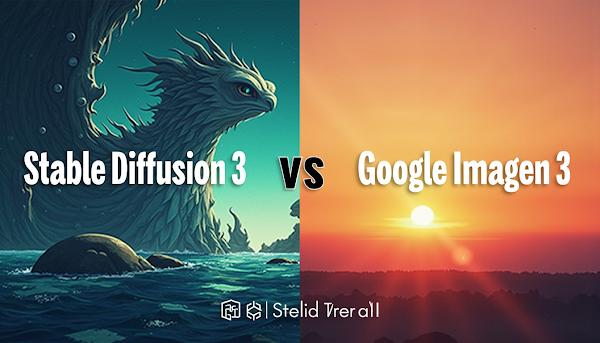Stable Diffusion 3 vs Google Imagen 3: A Comprehensive Comparison
Explore the key differences between Stable Diffusion 3 and Google Imagen 3, from image quality to features. Find out which AI model is right for you!
Introduction: Understanding the Power of AI Image Generation
AI-driven image generation has opened up a world of possibilities, enabling users to create realistic or fantastical images simply by typing a description. Among the most powerful and popular models are Stable Diffusion 3 and Google Imagen 3, both of which can generate high-quality images from text prompts. In this blog post, we’ll take a closer look at the features, advantages, and limitations of both models. By the end, you’ll have a better understanding of which model is better suited for your needs.
What Is Stable Diffusion 3?
The Evolution of Open-Source AI
Stable Diffusion 3 is the third iteration of the widely recognized open-source image generation model. It allows users to generate detailed images from textual descriptions, with a special emphasis on versatility and artistic flexibility. Being open-source, it has fostered a vibrant community of developers, researchers, and hobbyists who continually enhance and customize the platform.
Stable Diffusion 3 excels in artistic creativity and can produce highly diverse results, ranging from hyper-realistic images to more abstract and stylized works. The open-source nature allows users to experiment and customize the model according to their specific needs.
Key Features of Stable Diffusion 3:
- Open-source: Free to use and modify, with a strong community of developers.
- Customizable: Allows for fine-tuning and adjustment, enabling the generation of images in different artistic styles.
- High Flexibility: It can handle a wide variety of prompts and produce a range of creative outputs.
- Efficiency: Produces high-quality images with fewer resources compared to other models, thanks to its optimization.
Use Cases of Stable Diffusion 3:
- Digital Art Creation: Artists use it to quickly generate visual concepts and refine their work.
- Marketing: Companies use it to create ad visuals and promotional materials without the need for stock photos.
- Video Games: Developers use it for creating concept art and environmental visuals.

What Is Google Imagen 3?
The Power of Google’s AI Image Model
Google Imagen 3 is Google’s proprietary image-generation model, designed to generate stunning photorealistic images from text descriptions. Unlike Stable Diffusion, which is open-source, Google Imagen 3 is part of Google’s cutting-edge research in AI and is not available for public use. However, Google has made its research papers and demonstrations publicly accessible, showcasing the model’s impressive capabilities.
Google Imagen 3 focuses on achieving a high level of realism and fine detail in the images it generates. It has been trained on massive datasets, allowing it to produce photorealistic images that closely match the prompts it receives.
Key Features of Google Imagen 3:
- Photorealism: Google Imagen excels in creating highly realistic images that are virtually indistinguishable from real-world photographs.
- Advanced Text Understanding: The model understands the nuances of text prompts, enabling it to generate images with impressive detail and accuracy.
- High Fidelity: Google emphasizes image fidelity and clarity, minimizing distortions and artifacts.
- Exclusive Model: Unlike Stable Diffusion, Google Imagen 3 is not open-source, limiting customization and user control.
Use Cases of Google Imagen 3:
- Advertising: Ideal for companies seeking high-quality, realistic visuals for campaigns and promotional content.
- Content Creation: Used by digital content creators who need photorealistic images for websites, blogs, and social media.
- Product Design: Helpful for designers and manufacturers who want to visualize new products before creation.

Stable Diffusion 3 vs Google Imagen 3: A Feature Comparison
Image Quality
When comparing image quality, both models perform excellently, but with different strengths:
- Stable Diffusion 3: Known for its artistic flexibility, Stable Diffusion 3 can generate a wide variety of images ranging from stylized art to semi-realistic renderings.
- Google Imagen 3: Focuses primarily on photorealism, producing images that resemble real-world photographs with incredible detail.
Customization and Flexibility
One of the significant differences between the two models lies in their customization options:
- Stable Diffusion 3: As an open-source model, it offers more opportunities for developers and artists to modify the model and tailor it to specific use cases.
- Google Imagen 3: Lacks open-source access, limiting the ability to modify or customize the model. However, its simplicity can be seen as an advantage for users who prefer a streamlined experience.
Use Case Considerations
Stable Diffusion 3 is ideal for artists, developers, and researchers who require flexibility and customization. It’s perfect for those who want to create a variety of styles. On the other hand, Google Imagen 3 shines for businesses and creators who need high-fidelity, photorealistic images.
External Resources:
Performance and Speed
In terms of performance, Stable Diffusion 3 is relatively faster and less resource-intensive than other models like Google Imagen 3. While Google’s model produces incredibly accurate and realistic images, it tends to require more computational power and can be slower in certain scenarios.
Conclusion: Which AI Model Should You Choose?
Ultimately, your decision will depend on your needs:
- Choose Stable Diffusion 3 if you’re looking for an open-source, customizable tool that offers flexibility and artistic creativity.
- Choose Google Imagen 3 if you require highly realistic images for commercial, marketing, or content creation purposes and prefer a more straightforward, high-quality output.
Both models are groundbreaking in their own right, and either one could be the perfect fit depending on your use case. With ongoing advancements in AI image generation, we can expect even more exciting developments in the near future!

